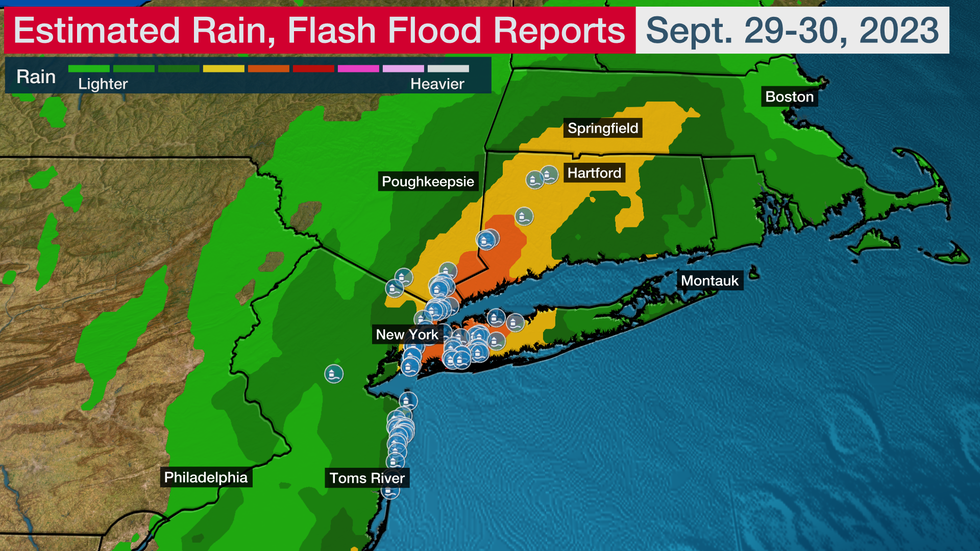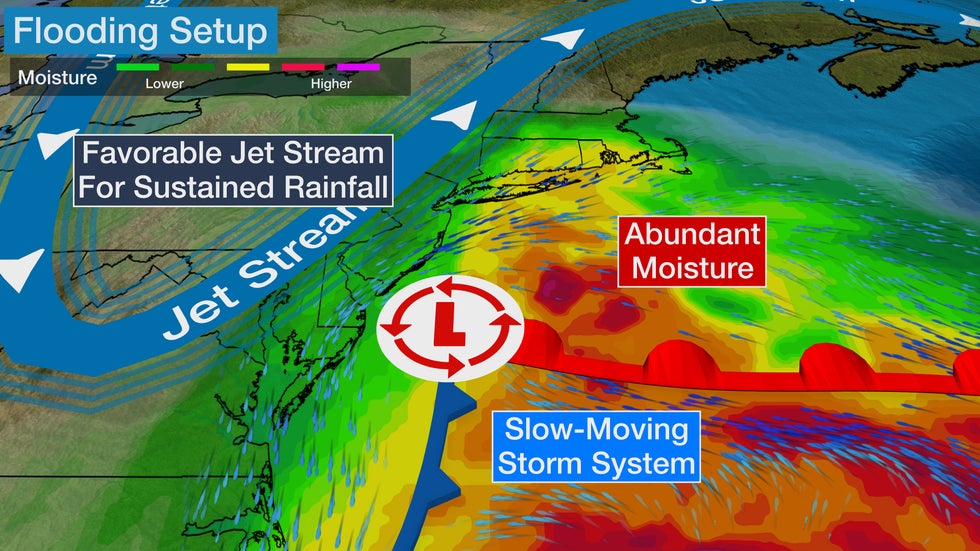Jonathan Erdman
Flooding rain swamped the New York City metro area, inundating streets, basements and subway stations all from a stagnant weather pattern that didn't include a tropical storm or hurricane.
(LATEST NEWS: Flooding Swamps NYC Metro)
What has happened already: Rain fell at rates up to 2 to 3 inches per hour in parts of the NYC metro on the morning of Sept. 29, particularly in Brooklyn. More than 8 inches of rain fell over western Long Island to midtown Manhattan. You can see a full list of rainfall reports here.
That quickly flooded streets, trapped vehicles, leaked into basements, cascaded into subway stations and even flooded Terminal A at LaGuardia Airport.

Why this happened: This was yet another case in which you don't need a tropical depression, storm or hurricane to produce flooding rain. You just needed some basic ingredients.
(MORE: What To Do To Stay Safe In A Flash Flood)
First, a slow-moving spin of low pressure aloft approached the Northeast from the Great Lakes, where it helped to wring out heavy rain in the upper Midwest earlier in the week.
A deep plume of tropical moisture was then pulled northward from the western Caribbean Sea toward the Northeast.
Weak low pressure formed off the East Coast, but near New York City, it took the form of a north-south oriented trough. That's basically a line where winds converge or come together. When those moist winds collided, they were lifted and formed the bands of rain that poured down on the region.
The other key ingredient is that winds aloft were both relatively weak and aligned in the same direction. That allowed the rainbands to train or reform and move over the same area for hours like boxcars of a train over the same section of track, instead of sweeping quickly away.

It didn't take a named storm. This may all leave New Yorkers flashing back to a pair of major flash floods two years ago, both with tropical systems or their remnants.
In 2021, Tropical Storm Henri and the remnant of Hurricane Ida each soaked the Northeast, including New York City, with torrential, flood-producing rain.
Henri, and the rain event before its arrival, dumped 4 to 10 inches of rain in the metro area over three days. In New Jersey, homes were flooded with 3 feet of water in Cranbury and evacuations were needed in Helmetta.
Less than two weeks later, the remnant of Ida combined with a stalled front to dump up to 10 inches of rain in one day in the Northeast. Forty-nine people were killed in the Northeast from flooding. Victims drowned in cars, were swept away by floodwater or were trapped in homes or apartments.
The peak rainfall rate measured at New York City's Central Park during this current event - 1.96 inches - was just under the peak measured during Henri, according to NOAA Weather Prediction Center meteorologist David Roth.
 Rainfall from Tropical Storm Henri (left) and Hurricane Ida (right) in 2021.
Rainfall from Tropical Storm Henri (left) and Hurricane Ida (right) in 2021.It's one of the city's wettest months in over 150 years. Together with three other heavy rain events within the last three weeks, New York's Central Park has had one of its top five wettest months in records dating to 1869.
It's also the city's wettest single month in over 12 years, since Hurricane Irene soaked the Northeast in August 2011.
They've already picked up over three times their average September rainfall of 4.31 inches.
It's also among the city's wettest calendar days on record, with over 5 inches of rain. Central Park's all time wettest day was 8.28 inches on Sept. 23, 1882.
John F. Kennedy Airport picked up over 8 inches of rain Friday, its record wettest single day since 2011.
Editor's note: This article was corrected to include more comprehensive one-hour rainfall rate data for New York's Central Park.
Jonathan Erdman is a senior meteorologist at weather.com and has been covering national and international weather since 1996. His lifelong love of meteorology began with a close encounter from a tornado as a child in Wisconsin. Reach out to him on X/Twitter, Facebook and Threads.
The Weather Company’s primary journalistic mission is to report on breaking weather news, the environment and the importance of science to our lives. This story does not necessarily represent the position of our parent company, IBM.
The Weather Company’s primary journalistic mission is to report on breaking weather news, the environment and the importance of science to our lives. This story does not necessarily represent the position of our parent company, IBM.

No comments:
Post a Comment